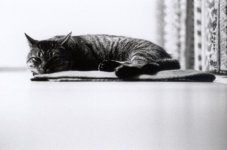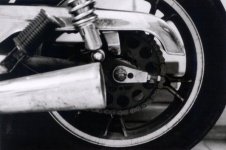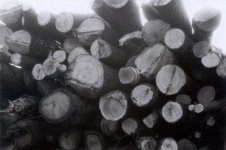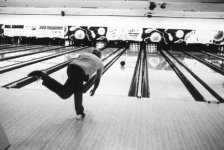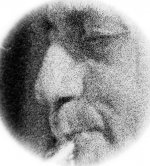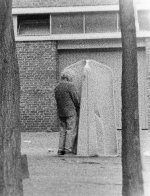imush
Well-known
It is my first time using this film (or anything this fast), although I obviously anticipated grain, but not to this extent:
http://www.mushinsky.net/photo/20071220/fl010028.jpg
http://www.mushinsky.net/photo/20071220/fl010035.jpg
Exposed at nominal 1600.
I am starting to shoot b&w after many years' break, and did not yet have the means to process the film myself, so sent it to a commercial lab, and am not very happy with the result. Does it look normal for this film, and what are the your recommendations to use and develop it (I'll do it myself next time)?
http://www.mushinsky.net/photo/20071220/fl010028.jpg
http://www.mushinsky.net/photo/20071220/fl010035.jpg
Exposed at nominal 1600.
I am starting to shoot b&w after many years' break, and did not yet have the means to process the film myself, so sent it to a commercial lab, and am not very happy with the result. Does it look normal for this film, and what are the your recommendations to use and develop it (I'll do it myself next time)?
Last edited:
cinematix
Member
It looks normal for me and the grain looks good.
moonwire
Member
I don't think the grain is excessive at all. Keep in mind that Neopan 1600 is in fact only about a third of a stop faster than Neopan 400 so you're basically pushing the film when you shoot at 1600.
I develop Neopan in Ilfotec DD-X and I have been pretty happy with the results (considering I only started shooting and developing film a couple of months ago).
I develop Neopan in Ilfotec DD-X and I have been pretty happy with the results (considering I only started shooting and developing film a couple of months ago).
Keith
The best camera is one that still works!
I've read very little but complementary reports about this film and your shots are no exception. The second pic appears to have been a little underexposed to me and the scan has probably introduced a little noise into the mix! 
pfoto
Well-known
Click on the link below for a thread over on PN about NP1600 with HC-110 and DD-X.
http://photo.net/bboard/q-and-a-fetch-msg?msg_id=00E1zO&tag=
http://photo.net/bboard/q-and-a-fetch-msg?msg_id=00E1zO&tag=
ed1k
Well-known
Those samples look almost normal for me taking into account the film was processed by a commercial lab. You have to adjust levels - all deep shadows are gray showing the grain.
In my experience, Neopan 1600 gives grain comparable with Tri-X 400, might be Tri-X gives slightly finer grain. If you like fine grain use ISO 100 films or Ilford Pan-F+
I develop everything in dual bath developer with metol and borax.
P.S. Here is my example of Neopan 1600, though it's almost impossible to talk about grain using web resolution scans. I have this photo printed 8"x10", grain is visible but not excessive, and this is a crop - used negative area was approximately 20mmx25mm.
http://rangefinder.ru/glr/showphoto.php/photo/4762/cat/500/ppuser/258
In my experience, Neopan 1600 gives grain comparable with Tri-X 400, might be Tri-X gives slightly finer grain. If you like fine grain use ISO 100 films or Ilford Pan-F+
I develop everything in dual bath developer with metol and borax.
P.S. Here is my example of Neopan 1600, though it's almost impossible to talk about grain using web resolution scans. I have this photo printed 8"x10", grain is visible but not excessive, and this is a crop - used negative area was approximately 20mmx25mm.
http://rangefinder.ru/glr/showphoto.php/photo/4762/cat/500/ppuser/258
Last edited:
imush
Well-known
Thanks for encouraging advice. Indeed it is hard to say from the scans, still subjectively other people's scans seem less grainy to me. I'll experiment more, and will try to expose it at slower setting.ed1k said:Those samples look almost normal for me taking into account the film was processed by a commercial lab. You have to adjust levels - all deep shadows are gray showing the grain...
foto_fool
Well-known
Actually these look look really good to me - in my hands I have found that this film has a tendency to produce halftones: blown highlights and black shadows. DDX is a good call for developing it yourself, though you will probably still get this much grain more often than not.
- John
- John
pvdhaar
Peter
What I find remarkable, is that the contrast in the prints is so low. It's like they've been underexposed and corrected for when printed. Maybe the meter in the camera got fooled the high lights (e.g. the fluorescents at the ceiling).imush said:I am starting to shoot b&w after many years' break, and did not yet have the means to process the film myself, so sent it to a commercial lab, and am not very happy with the result. Does it look normal for this film, and what are the your recommendations to use and develop it (I'll do it myself next time)?
I make it a habit to shoot fast films at a stop slower than advertised when having them developed at a lab. That way the process runs the other way, improving on contrast and grain..
Here's three examples I have with Neopan 1600.
First two are shot under ordinary conditions, the third has strong backlighting that tricked the meter into underexposure.. you can immediately see what it does with respect to contrast.
Attachments
Last edited:
sepiareverb
genius and moron
After some raves about this film by our late friend Magus, I gave this a try at his rated speed of 1250 and loved it. These days I shoot this at 1250, 800 if I'm in the summer woods, to control the extremes of contrast. As stated above, this isn't really a 1600 speed film. Your scans bear that out, looking 'pushed' and I think a little under-developed. I run this in ID-11 at 1:1, with the reduced agitation I use for all pushed film, and get some excellent results.
SolaresLarrave
My M5s need red dots!
It has been said, here in RFF and elsewhere, that a little extra development with this film goes a really long way. Hence, if you leave it in the developer for a few seconds more, you're increasing contrast in the negatives and prints. The advice I read about this film (which I've done in D-76 for 7:15') is that you should start draining the soup 10 seconds before time is up. That way you'll still salvage some intermediate tones.
Now... I prefer to push Agfa APX 400 at ISO 1600 instead.
But this thread is about the fast Neopan. I like it, it's never too grainy, and the contrast gives photos a kind of noir look.
See this one, taken in a bowling alley with my M6TTL and Hexanon 35/f2.

Now... I prefer to push Agfa APX 400 at ISO 1600 instead.
But this thread is about the fast Neopan. I like it, it's never too grainy, and the contrast gives photos a kind of noir look.
See this one, taken in a bowling alley with my M6TTL and Hexanon 35/f2.
Attachments
Marc-A.
I Shoot Film
I second several comments above.
1. your shots are not particularly grainy; it looks normal to me, especially in the 2nd picture.
2. the way you process your film is more important than the film itself.
Here's some shots, some are grainier than others:



Last one, Neopan 1600 at 3200 - very grainy, at least when scanned:

1. your shots are not particularly grainy; it looks normal to me, especially in the 2nd picture.
2. the way you process your film is more important than the film itself.
Here's some shots, some are grainier than others:



Last one, Neopan 1600 at 3200 - very grainy, at least when scanned:

RObert Budding
D'oh!
I rate it at EI 800 and get very nice shadow detail. I tried to push it to EI 3200, but I didn't like the loss of shadow detail. Great film, though. Amazingly fine grained for the speed.
Keith
The best camera is one that still works!
Wow Marc ... Nice!!!! I love the blacks of Neopan but I can't seem to get them like that consistantly! 
I've goneback to HP5 at the moment and am a little disappointed with the results. The greys and whites are sweet but I don't like the darker tones.
I've goneback to HP5 at the moment and am a little disappointed with the results. The greys and whites are sweet but I don't like the darker tones.
Roger Vadim
Well-known
you should bear in mind that you are shooting at 1600 in 35mm. you can't compare this to a t-grain 100 asa film. actually they look qite good to me, nice midtones, almost tri-x ish.
Steidl just released a very fine facsimile of the classic Ed van Elsken Book JAZZ. really nice grain here...
http://www.steidlville.com/books/526-Jazz.html
silver halide is all about light materialising in clumps of silver: grain...
Steidl just released a very fine facsimile of the classic Ed van Elsken Book JAZZ. really nice grain here...
http://www.steidlville.com/books/526-Jazz.html
silver halide is all about light materialising in clumps of silver: grain...
Last edited:
Trius
Waiting on Maitani
Pherdinand
the snow must go on
The film is fine, the grain looks alright to me, I agree with the above that the scans and/or development seems to be messed up a bit. Looks like the darks are completely black (either from development or from scanning) and were pushed up to gray digitally.
Did you do the scans? From prints or from the film?
Minilabs, even if they develop such film well, normally print on an automatic brightness adjustment stuff, and therefore the high contrast scenes usually lose the blacks, contrast drops and everything becomes gray. Forget about machine prints in such cases.
I only used Neopan 1600 in Diafine, at 1600 to 2400, and it looks good, especially at 1600.
Did you do the scans? From prints or from the film?
Minilabs, even if they develop such film well, normally print on an automatic brightness adjustment stuff, and therefore the high contrast scenes usually lose the blacks, contrast drops and everything becomes gray. Forget about machine prints in such cases.
I only used Neopan 1600 in Diafine, at 1600 to 2400, and it looks good, especially at 1600.
Pherdinand
the snow must go on
Roger Vadim said:...
silver halide is all about light materialising in clumps of silver: grain...
actually, grain shows up because of the gaps between the silver halide clumps.
That's why grains are black when you invert the negative, and not white.
Attached image about the musician is about 200x magnified from delta 3200. (Microscope+digicam)
And another one magnified don'tk-now-how-many-times, off Neopan 1600 at 1600 in xtol.
Attachments
Last edited:
titrisol
Bottom Feeder
Looks fine to me. Commercial develoment has drawbacks, and high speed film is one of those.
For next time I suggest you calibrate the developemnt/exposure by sending a roll to the same lab but bracket +2,+1,0,-1,-2 several images
Then check which of those images you like better and then shoot accordingly or ask the lab to push +XXX
You also do not tell us whether this is scan from negative or print?
For next time I suggest you calibrate the developemnt/exposure by sending a roll to the same lab but bracket +2,+1,0,-1,-2 several images
Then check which of those images you like better and then shoot accordingly or ask the lab to push +XXX
You also do not tell us whether this is scan from negative or print?
pphuang
brain drain...
As stated by others, I really like shooting Neopan 1600 around 800-1200. Its also a bit "punchier" than HP5, and so works especially well street shooting at small apetures in flat lighting (like on an overcast day). Here's one example:


Share:
-
This site uses cookies to help personalise content, tailor your experience and to keep you logged in if you register.
By continuing to use this site, you are consenting to our use of cookies.

